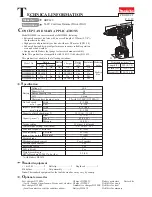
14
EN
O R I G I N A L I N S T R U C T I O N S
The hammer drill is equipped with a clutch that prevents overloading of the electric motor in case when the tool is jammed during
work, for example as a result of hitting a reinforcement wire. In such cases the drill will stop rotating, although the electric motor
is still working.
Also excessive pressure exerted on the tool during work may cause activation of the clutch.
In such cases remove the tool from the hole, make sure the hammer drill is functioning correctly and then resume work, applying
only the pressure which is necessary for proper operation. In case a reinforcement rod or another hidden metal obstacle is hit,
drill it using the hammer action function and a drill for metal of the same diameter as the hammer action drill, and then continue
drilling in the ceramic material.
Hammering
While the tool is disconnected from the mains install the required tool in the chuck: cutter or punch.
Set the operating mode selector to the hammering position. Plug the drill to the mains, turn the hammer drill on with the switch,
wait until it has reached the full speed and start work.
During hammering, do not drive the tool too much into the material to be processed. Hack the material o
ff
in thin layers, not exert-
ing excessive pressure on the hammer drill.
Using attachments
Drills with adjustable direction of rotation should not be used with attachments.
Protection of the drilling chuck
If the hammer drill is equipped with a rubber protection of the chuck, then it is recommended to use it in case of drilling with the
drill pointing up, e.g. for drilling in ceilings. Once the drill has been installed in the chuck, place the protection on it. Dust and debris
generated during drilling will accumulate in the protection, which permits to keep the chuck clean. Once work has ended, remove
the protection from the drill, remove dust and debris from the protection, and then rinse it under lukewarm water.
Additional remarks
During work do not exert excessive pressure on the material to be processed and do not make abrupt movements, so as not to
damage the tool and the drill. Make regular breaks during work. Avoid overloading the tool. The temperature of the external sur-
faces must not exceed 60
O
C. Once work has been
fi
nished, turn the drill o
ff
, unplug it from the mains and proceed to maintenance
and inspection.
The declared total value of vibrations has been determined by means of a standard method and it may be used for comparative
purposes. The declared total value of vibrations may be applied in the preliminary assessment of exposure.
Attention! The emission of vibrations during work with the tool may di
ff
er from the declared value, depending on the use of the tool.
Attention! It is required to determine safety means to protect the operator, which are based on assessment of exposure under
real operating conditions (including the whole working cycle, as for example the time when the tool is of or idling, and the time of
activation).
Lubrication
Before each use of drills or cutters they must be thoroughly cleaned and the SDS Plus chuck must be lubricated with a thin layer
of grease. It is recommended to use grease designed for the SDS Plus chucks. In case of incorrect operation of the hammer
action mechanism, one of the reasons may be incorrect lubrication of the gear and the crank assembly of the hammer action
piston. It is recommended to use grease designed for toothed and crank gears. It is recommended to have grease re
fi
lled in an
authorised service point.
MAINTENANCE AND OVERHAUL
ATTENTION! Before any adjustment, technical service or maintenance operations unplug the tool. Once the operations have been
fi
nished, the technical conditions of the tool must be assessed by means of external evaluation and inspection of the following
elements: body and handle, conductor with a plug and de
fl
ection, functioning of the electric switch, patency of ventilation slots,
sparking of brushes, noise level of functioning of bearings and gears, start-up and smoothness of operation. During the guarantee
period, the user cannot dismantle the electric tools or change any sub-assemblies or elements, since it will cancel any guarantee
rights. All irregularities detected at overhaul or during functioning of the tools are a signal to have the tool repaired at a service
shop. Once the functioning has been concluded, the casing, ventilation slots, switches, additional handle and protections must be
cleansed with a stream of air (at a pressure not exceeding 0.3 MPa), with a brush or a cloth without any chemical substances or
cleaning liquids. Tools and handles must be cleansed with a clean cloth.
Содержание YT-82123
Страница 21: ...21 RU residual current device RCD...
Страница 22: ...22 RU III SDS Plus SDS Plus SDS Plus V SDS Plus...
Страница 23: ...23 RU VI VIII...
Страница 24: ...24 RU 60 o C SDS Plus SDS Plus 0 3 MPa...
Страница 26: ...26 UA residual current device RCD...
Страница 27: ...27 UA III SDS Plus SDS Plus SDS Plus V SDS Plus VI...
Страница 28: ...28 UA VIII...
Страница 29: ...29 UA 60o C SDS Plus SDS Plus 0 3 MPa...
Страница 81: ...81 GR RCD RCD...
Страница 82: ...82 GR SDS Plus SDS Plus SDS Plus V SDS Plus VI...
Страница 83: ...83 GR VIII...
Страница 84: ...84 GR 60 C SDS Plus SDS Plus 0 3 MPa...
Страница 88: ...I N S T R U K C J A O R Y G I N A L N A 88...















































